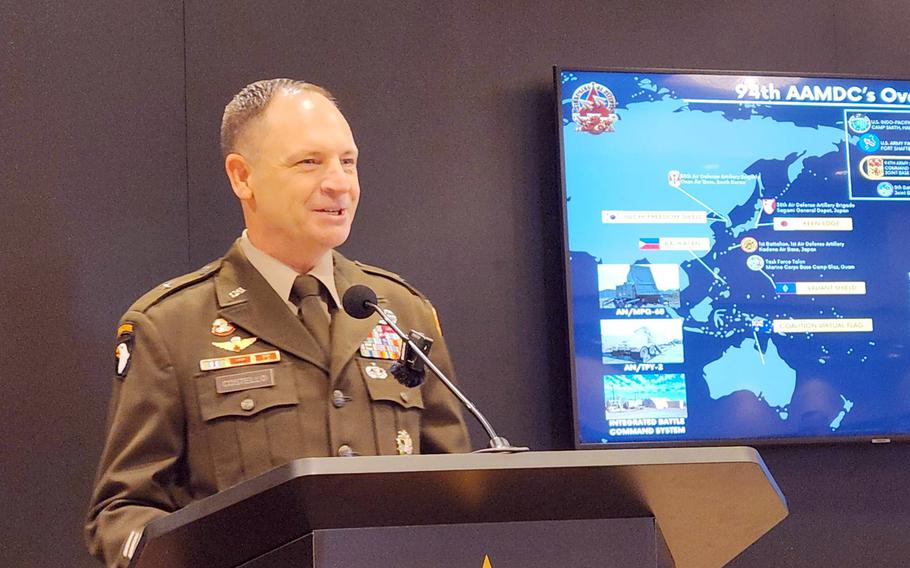
Army Brig. Gen. Patrick Costello, commander of the 94th Army Air and Missile Defense Command, speaks at the Land Forces Pacific, or LANPAC, symposium on Waikiki Beach in Hawaii, May 15, 2024. (Wyatt Olson/Stars and Stripes)
HONOLULU — The Army remains on track to deliver a “composite” missile-defense battalion that will become part of an integrated defense system for Guam, the commander of 94th Army Air and Missile Defense Command said Wednesday.
Guam is the test ground for the composite-battalion approach the Army will use to integrate its missile-defense capabilities, primarily the Terminal High Altitude Area Defense, or THAAD, and Patriot systems.
“I can’t comment on the exact timeline, but the Army remains on track on the commitments that they’ve made to [U.S. Indo-Pacific Command] to deliver capability on time,” Brig. Gen. Patrick Costello said during a question-and-answer session at the Land Forces Pacific, or LANPAC, symposium on Waikiki Beach.
“We are making strides on a daily basis on improving our defensive posture in Guam,” he said.
The 94th oversees the Army’s air defenses in the Indo-Pacific region and integrates them with those of the joint force and U.S. allies.
The Army’s Guam defense system will also employ the not-yet-fielded Indirect Fire Protection Capability, or IFPC — a mobile, ground-based system used to defeat cruise missiles, drones, rockets and mortars.
Costello said the Army will conduct the first live-fire testing of the integrated components on Guam before the end of the year.
Tying together the Army’s missile defense for Guam will be made possible by the Integrated Air Missile Defense Battle Command System that will be fielded over the next couple of years, Costello said.
The command system, designed by Northrop Grumman, can link any sensor or radar to any weapon anywhere, bypassing stove-piping that has historically kept missile-defense systems isolated from one another.
“By consolidating data from a number of different sensors, including radars, satellites and other partners and allies in the joint force, [the Battle Command System] creates a unified and comprehensive picture of the battlespace, providing expeditionary forces unparalleled situational awareness in decision-making capabilities,” Costello said.
The Army’s defense system will be just one part of the Pentagon’s integrated system planned for Guam.
Navy warships equipped with the Aegis Combat System and deployed as-needed to the region are also part of the plan, along with capabilities contributed by the Missile Defense Agency.
The Army’s Rapid Capabilities and Critical Technologies Office is overseeing the effort to integrate this overall Guam missile defense system.
Costello said the command system will require fundamentally changing how the 94th organizes and deploys assets and personnel.
“If we have things called THAAD batteries, Patriot battalions, IFPC battalions, divisional air defense battalions in the future, we’re doing something wrong,” he said.
“We’re not keeping up with the threat by having different formations for different threats. One formation needs to handle a wide variety of threats.”
Costello compared the new composite formations to the Marine Corps’ air-ground task force units, which are formed to accomplish a specific task under a single commander.
Establishing the Guam defense system will be “the first foray for the [Army] into organizing and operating as a composite organization,” Costello said.
“Unlike traditional single component units, composite battalions will be uniquely structured to integrate multiple assets and capabilities into a unified force,” he said.